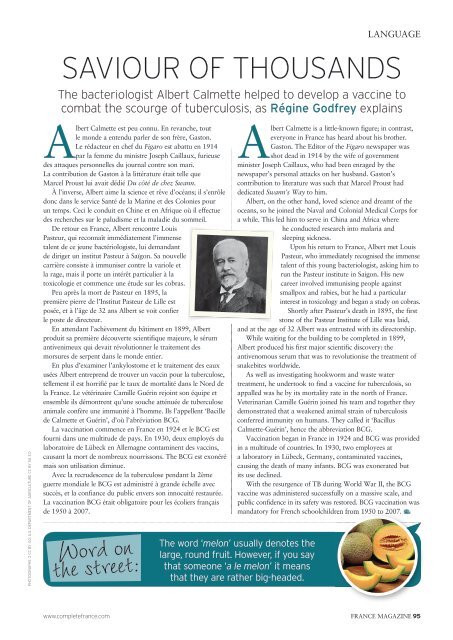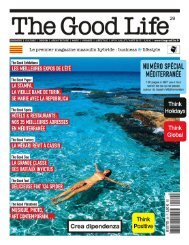Create successful ePaper yourself
Turn your PDF publications into a flip-book with our unique Google optimized e-Paper software.
LANGUAGE<br />
SAVIOUR OF THOUSANDS<br />
The bacteriologist Albert Calmette helped to develop a vaccine to<br />
combat the scourge of tuberculosis, as Régine Godfrey explains<br />
PHOTOGRAPHS: 2 CC BY 4.0; U.S. DEPARTMENT OF AGRICULTURE CC BY SA 3.0<br />
Albert Calmette est peu connu. En revanche, tout<br />
le monde a entendu parler de son frère, Gaston.<br />
Le rédacteur en chef du Figaro est abattu en 1914<br />
par la femme du ministre Joseph Caillaux, furieuse<br />
des attaques personnelles du journal contre son mari.<br />
La contribution de Gaston à la littérature était telle que<br />
Marcel Proust lui avait dédié Du côté de chez Swann.<br />
À l’inverse, Albert aime la science et rêve d’océans; il s’enrôle<br />
donc dans le service Santé de la Marine et des Colonies pour<br />
un temps. Ceci le conduit en Chine et en Afrique où il effectue<br />
des recherches sur le paludisme et la maladie du sommeil.<br />
De retour en <strong>France</strong>, Albert rencontre Louis<br />
Pasteur, qui reconnaît immédiatement l’immense<br />
talent de ce jeune bactériologiste, lui demandant<br />
de diriger un institut Pasteur à Saïgon. Sa nouvelle<br />
carrière consiste à immuniser contre la variole et<br />
la rage, mais il porte un intérêt particulier à la<br />
toxicologie et commence une étude sur les cobras.<br />
Peu après la mort de Pasteur en 1895, la<br />
première pierre de l’Institut Pasteur de Lille est<br />
posée, et à l’âge de 32 ans Albert se voit confier<br />
le poste de directeur.<br />
En attendant l’achèvement du bâtiment en 1899, Albert<br />
produit sa première découverte scientifique majeure, le sérum<br />
antivenimeux qui devait révolutionner le traitement des<br />
morsures de serpent dans le monde entier.<br />
En plus d’examiner l’ankylostome et le traitement des eaux<br />
usées Albert entreprend de trouver un vaccin pour la tuberculose,<br />
tellement il est horrifié par le taux de mortalité dans le Nord de<br />
la <strong>France</strong>. Le vétérinaire Camille Guérin rejoint son équipe et<br />
ensemble ils démontrent qu’une souche atténuée de tuberculose<br />
animale confère une immunité à l’homme. Ils l’appellent ‘Bacille<br />
de Calmette et Guérin’, d’où l’abréviation BCG.<br />
La vaccination commence en <strong>France</strong> en 1924 et le BCG est<br />
fourni dans une multitude de pays. En 1930, deux employés du<br />
laboratoire de Lübeck en Allemagne contaminent des vaccins,<br />
causant la mort de nombreux nourrissons. The BCG est exonéré<br />
mais son utilisation diminue.<br />
Avec la recrudescence de la tuberculose pendant la 2ème<br />
guerre mondiale le BCG est administré à grande échelle avec<br />
succès, et la confiance du public envers son innocuité restaurée.<br />
La vaccination BCG était obligatoire pour les écoliers français<br />
de 1950 à 2007.<br />
Word on<br />
the street:<br />
Albert Calmette is a little-known figure; in contrast,<br />
everyone in <strong>France</strong> has heard about his brother.<br />
Gaston. The Editor of the Figaro newspaper was<br />
shot dead in 1914 by the wife of government<br />
minister Joseph Caillaux, who had been enraged by the<br />
newspaper’s personal attacks on her husband. Gaston’s<br />
contribution to literature was such that Marcel Proust had<br />
dedicated Swann’s Way to him.<br />
Albert, on the other hand, loved science and dreamt of the<br />
oceans, so he joined the Naval and Colonial Medical Corps for<br />
a while. This led him to serve in China and Africa where<br />
he conducted research into malaria and<br />
sleeping sickness.<br />
Upon his return to <strong>France</strong>, Albert met Louis<br />
Pasteur, who immediately recognised the immense<br />
talent of this young bacteriologist, asking him to<br />
run the Pasteur institute in Saigon. His new<br />
career involved immunising people against<br />
smallpox and rabies, but he had a particular<br />
interest in toxicology and began a study on cobras.<br />
Shortly after Pasteur’s death in 1895, the first<br />
stone of the Pasteur Institute of Lille was laid,<br />
and at the age of 32 Albert was entrusted with its directorship.<br />
While waiting for the building to be completed in 1899,<br />
Albert produced his first major scientific discovery: the<br />
antivenomous serum that was to revolutionise the treatment of<br />
snakebites worldwide.<br />
As well as investigating hookworm and waste water<br />
treatment, he undertook to find a vaccine for tuberculosis, so<br />
appalled was he by its mortality rate in the north of <strong>France</strong>.<br />
Veterinarian Camille Guérin joined his team and together they<br />
demonstrated that a weakened animal strain of tuberculosis<br />
conferred immunity on humans. They called it ‘Bacillus<br />
Calmette-Guérin’, hence the abbreviation BCG.<br />
Vaccination began in <strong>France</strong> in 1924 and BCG was provided<br />
in a multitude of countries. In 1930, two employees at<br />
a laboratory in Lübeck, Germany, contaminated vaccines,<br />
causing the death of many infants. BCG was exonerated but<br />
its use declined.<br />
With the resurgence of TB during World War II, the BCG<br />
vaccine was administered successfully on a massive scale, and<br />
public confidence in its safety was restored. BCG vaccination was<br />
mandatory for French schoolchildren from 1950 to 2007.<br />
The word ‘melon’ usually denotes the<br />
large, round fruit. However, if you say<br />
that someone ‘a le melon’ it means<br />
that they are rather big-headed.<br />
www.completefrance.com FRANCE MAGAZINE 95






